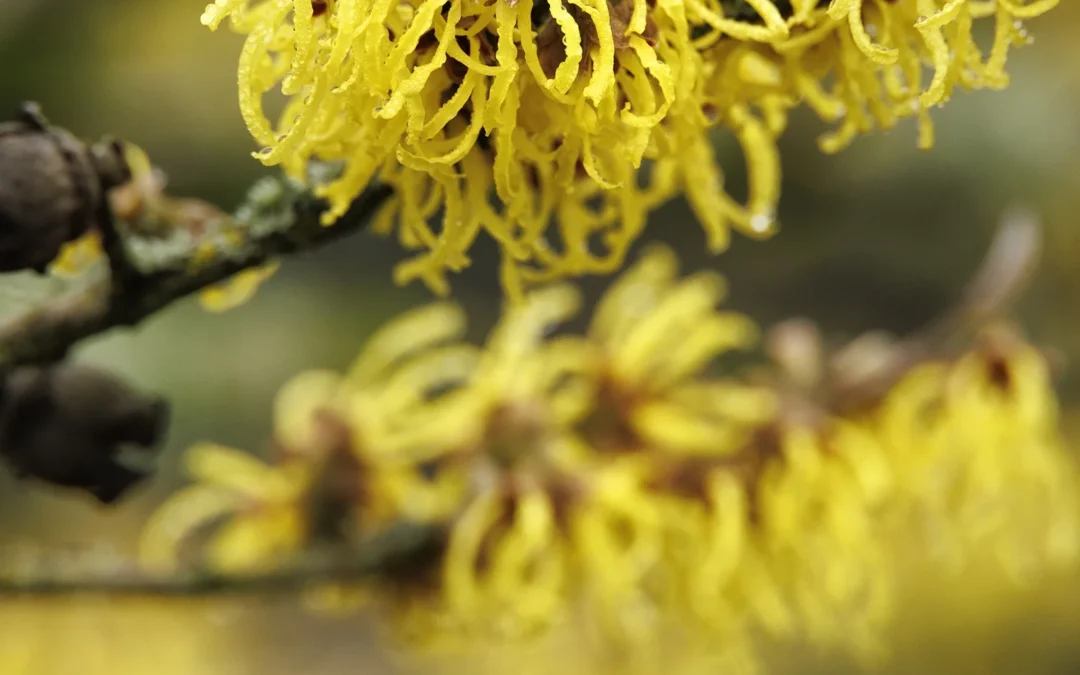
Common Name: Arnold Promise Witch Hazel
Bloom Time: Late winter to early spring (February–March)
USDA Zones: 5–8 (hardy in Southeastern Wisconsin)
Mature Size: 12–15 ft. tall × 10–12 ft. wide
Habit: Vase-shaped, multi-stemmed shrub
Flower Color: Bright yellow, fragrant, ribbon-like petals
Introduction
When most of the garden is still asleep under a blanket of snow, Arnold Promise Witch Hazel wakes up the landscape with a burst of sunshine-yellow blooms. One of the earliest flowering shrubs for Southeastern Wisconsin, it brings color, fragrance, and hope to late winter when gardeners need it most. Its ribbon-like petals unfurl on bare branches, often when snow is still on the ground, and perfume the air with a sweet, spicy scent.
This cultivar is part of the hybrid group Hamamelis × intermedia and is celebrated for its showy late-winter flowers, strong cold hardiness, and reliable garden performance.
Heritage Hill Nursery carries this standout selection:
👉 Shop Arnold Promise Witch Hazel
Origins & Description
Witch hazels are native to both North America and Asia, with hybrid forms (Hamamelis × intermedia) bred to combine the best traits of their parent species. ‘Arnold Promise’ was introduced by the Arnold Arboretum in Massachusetts and has since become a classic late-winter bloomer for northern gardens.
This deciduous shrub grows in a graceful, vase-shaped form, eventually reaching 12–15 feet tall and 10–12 feet wide. The standout feature is its fragrant, spidery yellow blooms, appearing in late February or March. Flowers often overlap with snowmelt, making them a rare source of early-season color and nectar.
In autumn, foliage turns brilliant shades of golden yellow, extending its ornamental value. The bark and branch structure also provide winter interest, making Arnold Promise a true four-season shrub.
Ideal Growing Conditions (Southeast Wisconsin Focus)
-
Light: Full sun to part shade. Best flowering occurs with at least 6 hours of direct sun.
-
Soil: Prefers loamy, well-drained soils, rich in organic matter. Avoid heavy, poorly drained clay.
-
Moisture: Evenly moist soil is ideal. While established plants tolerate some drought, consistent moisture supports stronger blooms.
-
pH: Slightly acidic to neutral soils (5.5–7.0).
-
Hardiness: Zone 5 hardy; thrives in Wisconsin winters with no extra protection once established.
Planting & Establishment
When to Plant:
How to Plant:
-
Dig a hole twice as wide and as deep as the root ball.
-
Place the shrub so the crown is level with the surrounding soil.
-
Backfill with soil enriched with compost.
-
Water thoroughly and mulch with 2–3 inches of organic material, keeping mulch a few inches away from stems.
Spacing: Plant 10–12 feet apart if using multiple shrubs to allow room for natural spread.
Care & Maintenance
-
Watering: Regular watering the first 2 years ensures a strong root system. After establishment, only water during prolonged dry spells.
-
Feeding: In spring, apply a balanced, slow-release fertilizer or compost to promote flowering and foliage health.
-
Pruning: Minimal. Prune lightly after flowering in spring to shape or remove deadwood. Avoid heavy pruning, as it can reduce next year’s bloom.
-
Pests & Disease: Generally pest- and disease-free. Deer usually leave witch hazels alone.
-
Winter Care: No special protection needed. Flowers withstand cold snaps; petals may curl in freezing temps but unfurl again with warmer weather.
Landscape Uses & Companions
-
Specimen Plant: Place in a prominent spot where its late-winter blooms can be enjoyed. Near entryways or patios is ideal.
-
Mixed Borders: Combine with other early bloomers like hellebores or snowdrops for layered late-winter interest.
-
Woodland Edge: Thrives at the edge of a woodland garden where it can catch sunlight.
-
Four-Season Interest: Offers winter flowers, spring freshness, summer greenery, and brilliant fall foliage.
Companions: Early-blooming bulbs (crocus, snowdrops, daffodils), shade-tolerant perennials (hosta, astilbe), and other shrubs with staggered bloom times (serviceberry, viburnum).
Seasonal Calendar (Wisconsin)
-
February–March: Fragrant yellow blooms open on bare branches.
-
April–May: Leaf-out; fertilize lightly.
-
Summer: Dense green foliage provides shade and structure.
-
September–October: Leaves turn golden yellow.
-
Winter: Strong branching adds interest against snow; buds prepare for next season.
Troubleshooting
-
Poor Bloom: Usually due to too much shade or water stress in summer. Relocate to sunnier, evenly moist soil.
-
Leggy Growth: Caused by excessive shade. Light pruning after bloom helps maintain form.
-
Slow Growth: Witch hazels are naturally slow to establish; patience pays off with decades of beauty.
Ecological & Garden Value
-
Pollinators: Provides nectar for early pollinators, including bees, when few other plants are blooming.
-
Wildlife Resistance: Rarely browsed by deer or rabbits.
-
Four-Season Beauty: Flowers, foliage, and structure keep the garden attractive year-round.
-
Native Heritage: Though a hybrid, it shares traits with North American witch hazels, which were historically used for medicinal purposes.
Ready to Plant?
If you want to bring a burst of life and fragrance to the late-winter garden, the Arnold Promise Witch Hazel is the shrub for you. With its dependable bloom time, glowing fall color, and easy-care nature, it’s an excellent choice for Wisconsin landscapes.
👉 Shop Arnold Promise Witch Hazel
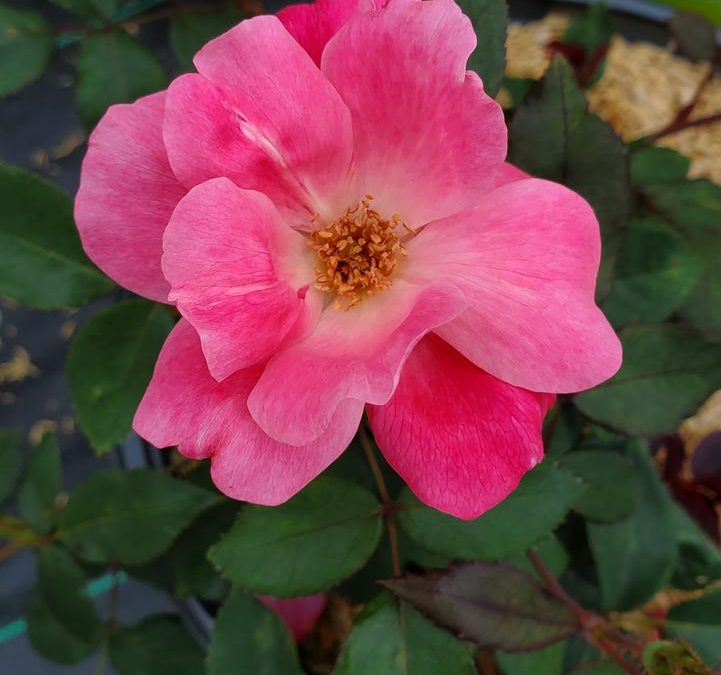
Common Name: Pink Knock Out® Rose
Bloom Time: Late spring until frost (May–October)
USDA Zones: 5–10 (winter hardy in Southeastern Wisconsin with minimal protection)
Mature Size: 3–4 ft. tall × 3–4 ft. wide
Habit: Rounded, bushy, continuous-blooming shrub rose
Flower Color: Bright, bubblegum-pink single to semi-double blossoms
Introduction
For gardeners in Southeast Wisconsin who love roses but dread the fuss, the Pink Knock Out® Rose offers the perfect solution. This vibrant, carefree shrub rose blooms abundantly from late spring until the first frost, filling the garden with cheerful pink color for months on end. Unlike traditional roses that demand constant spraying and pampering, Knock Out® roses are known for their disease resistance, self-cleaning blooms, and low-maintenance appeal.
You can find the Rosa Pink Knock Out® right here at Heritage Hill Nursery:
👉 Shop the Pink Knock Out® Rose
Origins & Description
Introduced in the early 2000s as part of the world-famous Knock Out® family, the Pink Knock Out® rose quickly became a favorite for homeowners and landscapers alike. It maintains all the durability of the original red Knock Out® but trades the fiery hue for a soft, bubblegum-pink blossom.
Each flower opens as a single to semi-double bloom, roughly 2–3 inches across, with five to ten petals and a sunny yellow center that draws the eye. The flowers appear in clusters, and because they are self-cleaning, spent petals drop naturally — no tedious deadheading required. Its glossy green foliage provides a handsome backdrop, staying healthy and fresh even in humid Wisconsin summers.
The shrub grows into a neat, rounded mound about 3–4 feet tall and wide, making it versatile enough for borders, foundation plantings, or container gardens.
Ideal Growing Conditions (Southeast Wisconsin Focus)
-
Light: Full sun (6–8 hours daily) is best for heavy bloom production.
-
Soil: Prefers well-drained loam enriched with organic matter. Adaptable to clay or sandy soils if drainage is improved.
-
Moisture: Roses like consistent soil moisture. Water deeply once a week, especially in summer. Avoid overhead watering to keep foliage dry.
-
pH: Neutral to slightly acidic soils (6.0–6.8) are ideal.
-
Hardiness: Reliably hardy in Zone 5. In especially cold winters, a light mulch mound over the crown helps protect against freeze–thaw cycles.
Planting & Establishment
Best Planting Times:
-
Spring (May–June): Gives the shrub the longest growing season to establish before winter.
-
Early Fall (September): Roots continue to grow even as the air cools, helping prepare for next spring.
How to Plant:
-
Dig a hole about twice as wide as the container and the same depth.
-
Place the plant so the crown sits just above the soil line.
-
Backfill with soil mixed with compost.
-
Water thoroughly and mulch with 2–3 inches of organic mulch, keeping it away from the crown.
Care & Maintenance
-
Watering: Provide 1 inch of water per week, more in drought. Water at the base of the plant.
-
Feeding: Fertilize in spring with a balanced, slow-release rose fertilizer. For continuous performance, a midseason boost in July keeps plants blooming strong.
-
Pruning: In early spring, cut back by about one-third to shape and encourage fresh, vigorous growth. Remove any dead or damaged canes at this time.
-
Deadheading: Not required — the plant self-cleans. However, light trimming can keep the shrub especially tidy.
-
Pest & Disease: Excellent resistance to black spot, mildew, and rust. Minimal pest issues when grown in proper conditions.
-
Winter Care: In late fall, mound mulch or shredded leaves around the crown for extra insulation in exposed sites.
Landscape Uses & Companions
-
Foundation Planting: Use as a cheerful accent near walkways and entryways.
-
Mass Planting: Plant in groups for a pink carpet effect that lasts all summer.
-
Mixed Borders: Combines well with other sun-loving perennials like salvia, coneflowers, and daylilies.
-
Containers: Excellent for large pots — try pairing with trailing plants like sweet potato vine or lobelia for contrast.
-
Pollinator Gardens: Open flowers attract bees and other pollinators.
Seasonal Care Calendar
-
April: Remove winter mulch, prune by one-third, and fertilize.
-
May–June: First bloom flush; water consistently.
-
July–August: Continuous flowering; apply a midseason fertilizer boost if desired.
-
September–October: Last flush of flowers; water until the ground freezes.
-
November: Apply winter mulch mound if in an exposed location.
Troubleshooting
-
Few Blooms: Usually caused by too little sunlight or over-fertilization with high nitrogen.
-
Yellowing Leaves: Often due to poor drainage or lack of nutrients. Amend soil or add balanced fertilizer.
-
Winter Dieback: Prune back to healthy wood in spring; Knock Out® roses are vigorous and bounce back quickly.
Ecological & Garden Value
The Pink Knock Out® Rose combines the best of both worlds — it provides beauty and pollinator value without the fuss. Its continuous bloom cycle ensures a steady nectar supply for bees, while its tidy form and resilience make it an ideal shrub for urban and suburban gardens. For Wisconsin homeowners seeking a low-maintenance rose with nonstop color, this is one of the best investments you can make.
Ready to Plant?
Bright, carefree, and bursting with blooms, the Pink Knock Out® Rose is an essential shrub for Wisconsin gardens. Add this reliable performer to your landscape and enjoy months of effortless color.
👉 Shop the Pink Knock Out® Rose
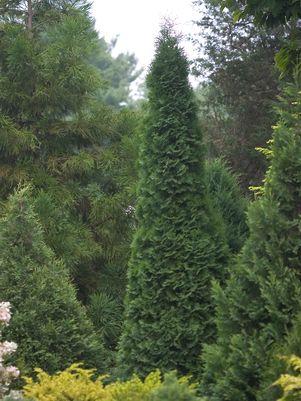
Common Name: North Pole® Arborvitae
Bloom Time: Evergreen (year-round interest)
USDA Zones: 3–7 (exceptionally hardy in Southeastern Wisconsin)
Mature Size: 10–15 ft. tall × 3–5 ft. wide
Habit: Narrow, columnar evergreen
Foliage: Dense, dark green, holds color through winter
Introduction
For homeowners in Southeastern Wisconsin who want a slim, space-saving evergreen with year-round presence, the North Pole® Arborvitae is hard to beat. With its tall, columnar habit and rich green foliage, this selection of American arborvitae is perfect for creating privacy screens, windbreaks, or elegant vertical accents in the landscape. Unlike broader arborvitae cultivars, North Pole® maintains a narrow footprint while reaching 10–15 feet in height, making it ideal for smaller lots or tight planting areas.
Find the Thuja occidentalis ‘North Pole’ at Heritage Hill Nursery here:
👉 Shop North Pole® Arborvitae
Origins & Description
The American arborvitae (Thuja occidentalis) is native to North America, thriving naturally in the upper Midwest and Northeast. Over time, plant breeders have developed cultivars to suit modern landscapes. North Pole® is a Proven Winners® selection prized for its dense, upright growth and cold hardiness.
The foliage is lush, dark green, and retains its color throughout winter, even in Wisconsin’s cold, snowy conditions where some evergreens may bronze. Its natural columnar form means it typically needs little to no pruning to stay neat and narrow. This makes it a fantastic option for low-maintenance hedges, natural fences, or focal-point plantings.
Ideal Growing Conditions (Southeast Wisconsin Focus)
-
Light: Full sun to part sun. Grows best with at least 6 hours of direct sun daily.
-
Soil: Prefers moist, well-drained soils, but tolerates clay and sandy conditions with adequate care.
-
Moisture: Consistent moisture is important, especially in the first 1–2 years. Once established, it is moderately drought tolerant.
-
pH: Neutral to slightly alkaline soils are ideal.
-
Hardiness: Extremely cold-hardy, thriving in Zone 3 winters. Perfectly suited to Wisconsin’s climate.
Planting & Establishment
When to Plant:
-
Spring (April–May): Gives roots the longest time to settle before winter.
-
Early Fall (September): Also effective, as roots will continue to grow while the soil is warm.
How to Plant:
-
Dig a hole twice as wide as the root ball and equal in depth.
-
Place the plant so the crown is level with the soil surface.
-
Backfill with native soil, firm gently, and water thoroughly.
-
Apply a 2–3 inch mulch ring around the base to conserve moisture, keeping mulch a few inches away from the trunk.
Spacing: For privacy screens, plant 3–5 feet apart. For stand-alone specimens, allow full width (about 5 feet) to let the natural shape shine.
Care & Maintenance
-
Watering: Water deeply and regularly during the first two years. Established plants can handle some drought, but occasional deep watering keeps them healthiest.
-
Fertilizer: Apply a balanced, slow-release fertilizer in spring for optimal growth. Avoid excessive nitrogen.
-
Pruning: Minimal. Naturally narrow, but can be lightly trimmed in late spring if needed. Avoid heavy pruning into old wood.
-
Winter Care: In windy or exposed sites, burlap wraps can prevent winter burn in the first few years. Avoid piling snow directly against plants.
-
Longevity: With proper care, North Pole® can thrive for decades as a structural anchor in the landscape.
Landscape Uses & Companions
-
Privacy Screens: Narrow footprint makes it excellent for hedges along property lines.
-
Windbreaks: Plant in rows to reduce wind around patios or gardens.
-
Focal Points: Use as vertical accents in mixed borders or near entryways.
-
Foundation Plantings: Adds evergreen structure without overwhelming smaller homes.
-
Companions: Pair with ornamental grasses, hydrangeas, spirea, or flowering perennials for seasonal contrast.
Seasonal Calendar (Wisconsin Care)
-
Spring: Plant new specimens, fertilize, and water deeply.
-
Summer: Maintain consistent watering in hot, dry stretches.
-
Fall: Planting window remains open until the ground freezes. Water well before winter.
-
Winter: Monitor for snow or ice damage; brush off heavy snow loads to prevent branch breakage.
Troubleshooting
-
Browning Foliage: Often caused by drought stress or winter burn. Water regularly in fall before freeze-up, and protect young plants in exposed sites.
-
Sparse Growth: Insufficient sunlight may cause legginess; plant in full sun whenever possible.
-
Deer Damage: Arborvitae are often browsed by deer. In areas with heavy deer pressure, consider fencing or repellents.
Ecological & Garden Value
-
Wildlife Shelter: Provides cover for birds year-round.
-
Air Quality: Evergreens like arborvitae filter air and reduce noise pollution.
-
Sustainable Screening: Offers a natural alternative to fences, with added aesthetic and ecological benefits.
Ready to Plant?
If you’re seeking an upright, narrow evergreen that thrives in Wisconsin’s climate, North Pole® Arborvitae is an outstanding choice. Low-maintenance, cold-hardy, and space-saving, it’s equally at home as a privacy hedge, windbreak, or specimen planting.
👉 Shop North Pole® Arborvitae
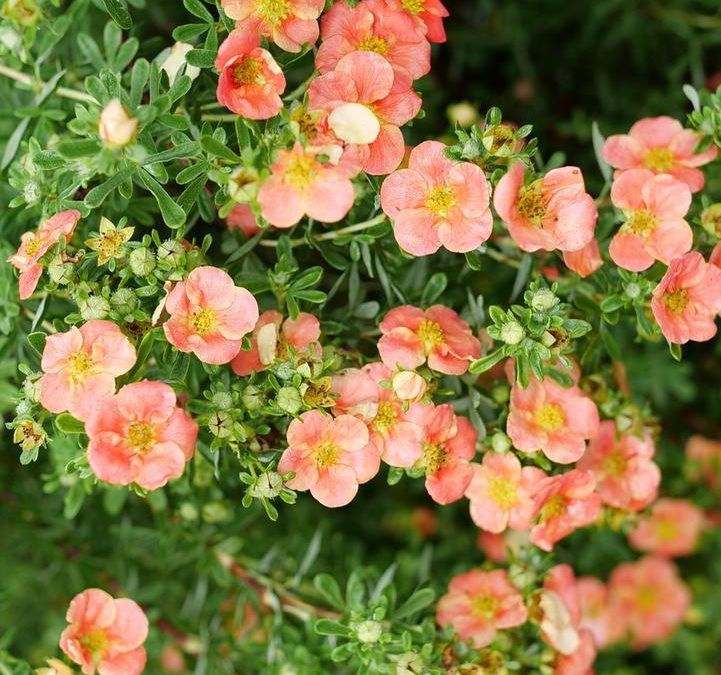
Common Name: Happy Face® Hearts Potentilla
Bloom Time: Late spring through frost (May–October)
USDA Zones: 2–7 (exceptionally hardy in Southeast Wisconsin)
Mature Size: 2–3 ft. tall × 2–3 ft. wide
Habit: Compact, rounded shrub
Flower Color: Cheerful yellow to orange blooms with soft red highlights
Introduction
When many shrubs are finishing their show, Happy Face® Hearts Potentilla is just getting started. Blooming reliably from late spring until the first frost, this tough, sun-loving shrub offers a months-long display of cheerful flowers against tidy green foliage. Known for its resilience, adaptability, and ease of care, it’s one of the most versatile flowering shrubs for Wisconsin gardens. Whether you’re planting a pollinator-friendly border, a foundation accent, or a low-maintenance landscape design, this potentilla delivers season-long color with very little upkeep.
Heritage Hill Nursery offers several outstanding potentilla selections, including Happy Face® Orange Potentilla—a close cousin with the same carefree performance and vibrant blooms. Explore it here:
https://heritagehillnurseryinc.com/product/potentilla-fruticosa-happy-face-orange/
Origins & Description
Potentilla, sometimes called shrubby cinquefoil, is native to cooler regions of the Northern Hemisphere, where it thrives in open meadows, prairies, and mountain slopes. Bred selections like Happy Face® Hearts were introduced to improve both flower size and color vibrancy while maintaining the species’ rugged toughness.
The shrub’s dense, mounded habit makes it an excellent choice for low hedges, mixed borders, or mass plantings. Each bloom is a bright splash of yellow-orange with red undertones, producing a warm, glowing effect that shifts with the angle of the sun. The fine-textured, fern-like foliage stays fresh and green all summer, even in hot or dry spells, giving the plant ornamental value long after peak bloom.
Ideal Growing Conditions (Southeast Wisconsin Focus)
-
Light: Full sun is best—at least 6 hours per day ensures maximum blooms.
-
Soil: Adaptable to a wide range of soils, from sandy to clay. Good drainage is essential.
-
Moisture: Once established, it is quite drought-tolerant. Regular watering the first year promotes strong root systems.
-
pH: Tolerates acidic to slightly alkaline soils (pH 5.5–7.5).
-
Hardiness: Withstanding Wisconsin winters down to –40°F, it’s one of the hardiest flowering shrubs available.
Planting & Establishment
Timing: Best planted in spring or early fall. Both allow roots to establish before stress from summer heat or deep winter cold.
How to Plant:
-
Dig a hole twice the width of the container and equal depth.
-
Place shrub so the crown sits level with the surrounding soil.
-
Backfill with native soil, firm gently, and water thoroughly.
-
Apply a 2–3 inch mulch layer around the base, keeping mulch 2 inches away from stems to prevent rot.
Spacing: Plant 2–3 feet apart if used in groupings or as a hedge to allow air circulation and natural form.
Care & Maintenance
-
Watering: Water deeply once a week during dry spells in the first year. Mature plants are drought-tolerant and rarely need supplemental watering except in prolonged drought.
-
Fertilizer: Minimal needs. A light application of balanced fertilizer in spring promotes fresh growth and abundant bloom.
-
Pruning: After bloom, lightly trim to maintain shape. In early spring, remove any dead wood or weak stems to encourage vigorous new shoots.
-
Pests/Disease: Naturally resistant to most pests and diseases. Rarely troubled by deer or rabbits, making it an excellent choice for wildlife-heavy areas.
-
Longevity: With minimal care, potentilla can thrive for decades, making it a long-term landscape investment.
Propagation
Potentilla can be propagated by softwood cuttings in summer or by division in spring, although most gardeners prefer to purchase named cultivars to ensure flower color consistency.
Landscape Uses & Companions
-
Foundation Planting: Use as a colorful, low-growing shrub near the house, where its season-long bloom softens hard edges.
-
Mass Planting: Ideal for slopes or large open beds where you want a bright, continuous display of color.
-
Pollinator Gardens: Flowers provide nectar for bees, butterflies, and hoverflies.
-
Mixed Borders: Combine with shrubs like spirea, dwarf lilac, or ninebark for continuous bloom sequences.
-
Companions: Pairs beautifully with ornamental grasses, daylilies, salvia, and coneflowers.
Seasonal Calendar (Wisconsin)
-
April–May: Spring cleanup; light fertilizer.
-
Late May–June: First flush of flowers begins.
-
July–September: Continuous flowering with light deadheading or shaping.
-
October: Still blooming until frost; foliage remains attractive.
-
Winter: No care needed—shrubs rest quietly until spring.
Troubleshooting
-
Sparse Bloom: Usually due to too much shade. Move to a sunnier spot for more flowers.
-
Overgrown Shape: Can be rejuvenated by cutting one-third of the plant back in early spring.
-
Yellowing Leaves: Often a sign of waterlogged soil. Ensure good drainage.
Ecological & Garden Value
-
Pollinators: Supports local bee populations and provides nectar late into fall when other plants fade.
-
Wildlife Resistance: Deer and rabbits generally avoid it.
-
Low-Maintenance: A true “plant it and forget it” shrub once established.
-
Climate Resilience: Cold-hardy and tolerant of drought, heat, and poor soils, making it an all-star for challenging Wisconsin sites.
Ready to Plant?
If you’re looking for a carefree, long-blooming shrub that provides reliable color and pollinator value, Happy Face® Hearts Potentilla is an ideal choice. At Heritage Hill Nursery, you can also explore close relatives like the Happy Face® Orange Potentilla, available here:
https://heritagehillnurseryinc.com/product/potentilla-fruticosa-happy-face-orange/
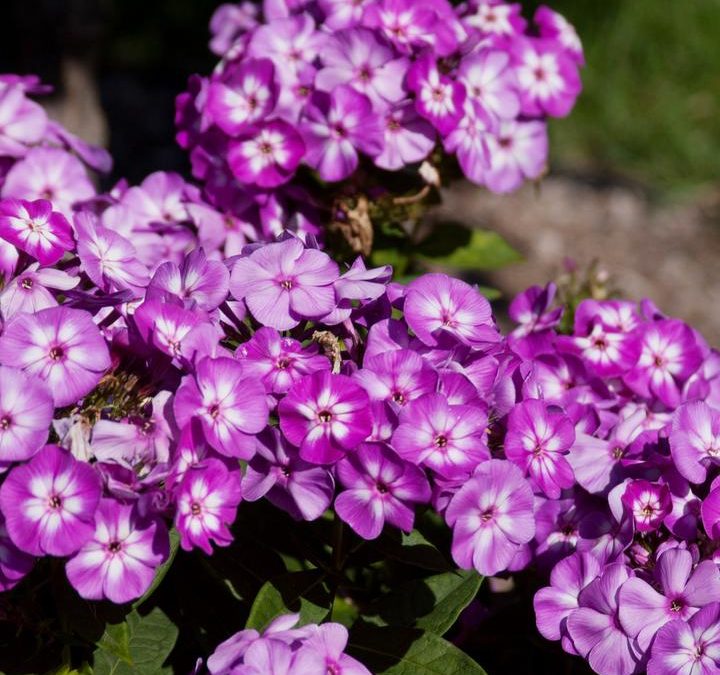
Common Name: Grape Lollipop Garden Phlox
Bloom Time: Mid-summer through early fall (July–September)
USDA Zones: 3–8 (reliably hardy in Southeast Wisconsin)
Mature Size: 18–24 in. tall × 18–24 in. wide
Habit: Compact, upright clump with rounded flower heads
Fragrance: Sweet, classic phlox scent
Introduction
Just when many perennials are starting to slow down, Grape Lollipop Phlox shifts into high gear with dome-shaped clusters of saturated, grape-purple flowers. Its compact habit, excellent color retention, and improved disease performance make it a go-to choice for late summer color in Southeast Wisconsin. Whether you’re refreshing a cottage border, brightening a pollinator bed, or planting a mixed container for the patio, this cultivar brings reliable, high-impact bloom with far less fuss than older phlox varieties.
Looking to plant this season? Heritage Hill Nursery carries Phlox paniculata ‘Grape Lollipop’—see it here:
https://heritagehillnurseryinc.com/product/phlox-paniculata-grape-lollipop/
Origins & Description
Phlox paniculata is the classic “garden phlox,” valued for tall stems topped with fragrant flower panicles that attract butterflies, bees, and hummingbirds. The ‘Grape Lollipop’ selection (botanical name ‘Ditomsur’) refines that formula: it stays neatly compact (generally under two feet), holds rounded, lollipop-like flower heads, and colors up in a deep grape-purple that reads vividly from a distance. Individual florets are five-petaled and can show a faintly lighter halo or small eye toward the center, adding dimension. Sturdy, medium-green foliage forms a dense mound that helps the plant look tidy even between bloom flushes.
Another advantage of this cultivar is its improved garden performance relative to older tall phlox—especially in regard to foliar diseases when given proper spacing and air flow. For home gardeners, that translates to a plant that maintains attractive leaves while pumping out blooms for weeks.
Ideal Growing Conditions (Southeast Wisconsin Focus)
-
Light: Full sun (6+ hours) yields the strongest stems, tightest habit, and most abundant flowers. In very hot exposures, a touch of afternoon shade is fine and can extend bloom.
-
Soil: Best in moist, well-drained, fertile soils. Work in 2–3 inches of compost before planting to boost structure and water-holding capacity, particularly in sandy or heavy clay sites common in our region.
-
pH: Slightly acidic to neutral (approx. 6.0–7.0) is ideal, but this phlox is adaptable if drainage and fertility are good.
-
Water: Keep evenly moist during active growth; aim for about 1 inch of water per week from rain or irrigation. Consistency helps maximize flower size and longevity.
-
Airflow: Good air circulation is essential. Space plants 18–24 inches apart and avoid crowding with bulky neighbors; this dramatically reduces mildew pressure.
-
Hardiness: Winter hardy across Southeastern Wisconsin. A light mulch after the ground freezes (late fall) helps moderate freeze-thaw cycles.
Planting & Establishment
Timing: Plant in spring after the last hard frost or in early fall (late August–September) so roots can establish while the soil is warm. Early fall planting is particularly effective here; roots keep growing into October even as tops slow down.
How to Plant:
-
Dig a hole twice as wide as the root ball and as deep as the pot.
-
Set the crown level with the surrounding soil—don’t bury the stems.
-
Backfill with native soil amended with compost, firm gently, and water thoroughly.
-
Top with 2–3 inches of organic mulch, keeping mulch 1 inch off the stems.
Aftercare, Year 1: Water deeply whenever the top couple inches of soil dry out. Consistent moisture in the first season sets the stage for a fuller plant and heavier bloom the following summer.
Care & Maintenance
-
Watering: Once established, water during dry spells to maintain steady growth and prevent stress-related leaf issues. Morning watering at the soil line (soaker hose or drip) is ideal.
-
Feeding: In early spring, scratch in a balanced, slow-release fertilizer or a thin layer of compost. Avoid high-nitrogen spikes midseason, which can push soft foliage at the expense of flowers.
-
Deadheading: Clip away spent flower heads to encourage a lighter rebloom and keep the plant looking tidy.
-
Cutback: In late fall after a hard frost or in early spring, cut stems back to 2–4 inches. Removing old stems improves airflow around the new shoots.
-
Division: Every 3–4 years, divide clumps in early spring to maintain vigor and produce additional plants. Replant divisions at original depth and water well.
-
Pests & Disease: Modern selections like ‘Grape Lollipop’ hold foliage well when spaced correctly. Still, practice good hygiene—clean up fallen leaves in autumn and water at soil level. If deer or rabbits are active in your area, consider a repellent during tender spring growth.
Design Ideas & Companions
-
Front-to-Mid Border Color: The smaller size of ‘Grape Lollipop’ fits perfectly at the front or mid border where traditional tall phlox might loom.
-
Pollinator Beds: Its nectar-rich blooms are excellent for butterflies, bees, and hummingbirds. Place near Echinacea, Monarda, Agastache, or Rudbeckia to build a succession of summer-to-fall food sources.
-
Texture Pairings: Contrast the rounded flower heads against fine grasses like Panicum ‘Northwind’ or Schizachyrium scoparium; the airy blades frame the bold color and extend interest into autumn.
-
Containers: In a 16–20″ patio pot, combine ‘Grape Lollipop’ with a mounded silver foliage plant (like Artemisia or Helichrysum) and a trailing accent (such as Calibrachoa) for long-season impact.
-
Color Palettes:
-
Monochrome: Pair with salvias and purple coneflowers for a cool violet scheme.
-
Complementary: Add golden yellows (e.g., Coreopsis, Helenium) for high-contrast pop in late summer.
-
Soft Pastels: Soften with pale pinks and whites (e.g., Phlox ‘David’, Shasta daisy) to create an evening-friendly border.
Seasonal Calendar (Southeast Wisconsin)
-
March–April: Clean up old stems; top-dress with compost; apply slow-release fertilizer.
-
May–June: Monitor moisture as growth accelerates; ensure spacing remains open around the plant.
-
July–September: Peak bloom. Deadhead spent clusters to neaten and extend the show.
-
October: Continue watering until the ground starts to freeze if rainfall is scarce—roots still grow in warm soil.
-
Late Fall: After a killing frost, cut back and mulch lightly once the ground has cooled.
Troubleshooting Tips
-
Powdery Mildew: Most often a spacing/airflow issue. Widen spacing, thin nearby plant bulk, water at soil level, and avoid overhead irrigation late in the day.
-
Flop/Lean: Rare with this compact cultivar. If it occurs after storms, a low, unobtrusive hoop support added early in the season can help.
-
Sparse Bloom: Typically from insufficient sun or over-rich nitrogen. Move to a brighter spot and use balanced feeding next spring.
-
Short Bloom Window: Deadhead promptly, maintain even moisture, and avoid severe drought stress to keep flowers coming.
Ecological & Garden Value
‘Grape Lollipop’ is a pollinator powerhouse at a time of year when fresh nectar is essential. Its continuous, fragrant bloom supports a range of beneficial insects, while the compact habit allows gardeners with smaller spaces to contribute meaningfully to backyard biodiversity. Because this cultivar holds foliage well, it also provides a more attractive, low-maintenance presence in ornamental beds through late season.
Ready to Plant?
Bring late-summer color to your garden with Phlox paniculata ‘Grape Lollipop’ (PP21,109)—compact, fragrant, and floriferous.
Shop it here: https://heritagehillnurseryinc.com/product/phlox-paniculata-grape-lollipop/





